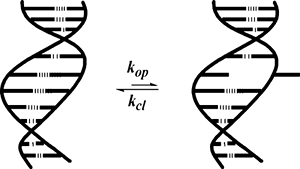
UD Priyakumar, AD MacKerell,


UD Priyakumar, AD MacKerell,


UD Priyakumar, AD MacKerell,

Molecular dynamics simulations were performed to investigate GC and AT base opening events in DNA. Calculated equilibrium constants between the base open (or flipped) and closed states were shown to be in good agreement with experimental data from NMR imino proton exchange experiments. Analysis of the computed results indicates that the equilbrium constants are dominated by the opening of the A and G bases in the AT and GC base pairs, respectively. Thus, the present results predict that NMR imino proton exchange experiments of base opening are primarily monitoring the opening of purine bases.

UD Priyakumar, AD MacKerell,

The improving quality of empirical force field parameters along with other methodological improvements and ever increasing computational resources have lead to more reliable computations on biological macromolecules. In the case of oligonucleotides, three force fields, namely CHARMM27, AMBER4.1, and BMS, have been developed and are widely used by the simulation community. Testing of these force fields to date has primarily focused on their treatment of the canonical forms of DNA and RNA. However, many biological functions of oligonucleotides involve significant variation of their structures from the canonical forms. In the present work, the three force fields are evaluated via computation of potentials of mean force (PMF) of the base flipping process in a DNA dodecamer, 5′-GTCAGCGCATGG-3′. Results are compared with available experimental data on the equilibrium between the opened and closed (i.e. Watson-Crick base paired) state of the underlined C and its WC partner G. Quantitative analysis shows CHARMM to be in the best agreement with experiment, closely followed by AMBER with BMS in the poorest agreement. Various components contributing to the change in the free energy such as base pair interactions, stacking interactions, solvation effects, and intrinsic potential energy changes were evaluated and compared. The results indicate that while all three force fields reasonably represent the canonical structures, the balance of forces contributing to their structural and dynamic properties differ significantly.